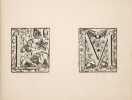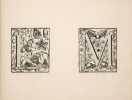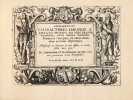3 books for « bry jean theodore de »Edit
-
Topics
Barber (1)
Illustrated books (1)
-
Countries
Belgium (1)
France (2)
-
Syndicate
ILAB (1)
SLAM (1)
Alphabeta et Characteres… Apud Omnes Omnino Nationes usurpatj ; ex varijs Autoribus accurate depromptj. Artificiose… in aere effictj, et recens forâs dati, per Io : Theodorum Et Io : Israelem De Bry, Fratres germanos… Edition originale et premier tirage du plus rare recueil d’alphabets « Alphabeta et Characteres » des frères de Bry, imprimée à Francfort en 1596.
Bel exemplaire de la bibliothèque A. Brölemann. Francfordij… 1596. In-4 oblong de (6) ff., 62 planches sur 51 ff. (manque ici le feuillet K2 orné des lettres E et F). Cuir de Russie fauve, filet doré autour des plats, dos à nerfs, filet or sur les coupes, charnières fragiles, roulette intérieure et tranches dorées. Reliure signée Bruyere, vers 1840. 146 x 199 mm.
Première édition originale de ce recueil des frères de Bry qui revendique de tracer tous les alphabets en usage dans les divers peuples du monde. Les alphabets latins furent tracés d’après les modèles de Corneille Agrippa et Baptiste Palatin. Hollstein Dutch and Flemish IV.37, n°119-169, Bonacini 290 ; cf. Becker : Hofer Collection 59 (citing German-language edition) ; Berlin 5283 ; Guilmard p. 369 ; Brunet I, 1309 ; Graesse VIII, 124. First edition, published simultaneously with a German-language issue (« Alphabeten , und aller art Characteren… »). The alphabet plates include representations of Chaldaen, Syriac, Hebrew, Coptic, Arabic, Samaritan, Greek, Illyrian, Croatian, Armenian, and Roman, among others, many of these in several different varieties, as well as national varieties of lettering styles - German, Flemish, French, and other - also demonstrating upper and lower cases and styles of script. Following these are 12 plates with an alphabet of 24 elaborate Mannerist initial letters by the de Bry brothers, exquisitely ornamented with lions, horses, unicorns, dogs, monkeys, cats, peacocks, turkeys, pelicans, owls, butterflies, beetles, and vines. The final three plates (of four published in the concluding section) include six handsome monogram devices for the brothers themselves and others, and two quatrains of verse in rebus form. This copy includes, however, the beautiful and very elaborate dedication engraving, which is not always present- a complex wreathed monogram for Count Philip Louis II of Hanau-Münzenberg, set between elegant figures of Justice and Truth, who stride forward from columned niches bearing scales and a mirror. Dans la description de son exemplaire incomplet Peter A. Wick ajoutait : « Like all other copies we have seen described, this volume does not include Plate A, and it would appear that it was never present, as Becker speculates with reference to the German issue of the work. » Le présent exemplaire contient la planche A1 qui reproduit la gravure de dédicace. « This antiquarian text, Alphabeta et characteres, first published in 1596 and later published in English in 1628 as Caracters and Diversitie of Letteres Used by Divers Nations in the World, the second alphabet book produced by the de Bry workshop in the 1590s, is comprised mostly of plates reproducing alphabets ancient and modern. The de Brys’ fanciful alphabet, in which letters are composed entirely of bodies, is therefore something of an exception in the larger historicizing program of the book, but it does offer a lesson in embodiement that applies to the book as a whole. The alphabet begins with Adam and Eve who, in their original sin, ‘fall’ into each other to become the letter A. This corporeal letter, linked to the Fall as surely as the A of the ‘Nova alphati’, once again suggests that in a fallen world it is only by means of the letter that we can embody our scriptural origins. Yet this is also a book full of alphabets in which time makes fallen bodies of letters. The corporeal letter cannot help but play a paradoxical role in a book whose historicizing purpose is to embody the origins of that which embodies our origins. It would be easy to explain away this problem by treating the fanciful A composed of Adam and Eve as a witty gloss on the simple letter A that is given, a priori, just below it; yet this simple A, printed in Roman capital, itself turns out to be a gloss on something prior to it. The plate from the ‘Alphabeta et characters’ illustrating the historicized Roman alphabet proves that this letter exists in time and must therefore be seen as a descendant of, for example, the curious A’s of two ancient Egyptian alphabets represented in a separate plate, letters that are themselves descendants of some prior letter. At some point, if we are to avoid lapsing into this infinite regression in which there will always be one more step to an original writing, a separation must be forced between the sacred truths borne by the letter and the letter as historical artifact. Perhaps once could argue, with Juliet Fleming, that the form this separation takes in response to the Renaissance tattoo is one of acknowledgment and disavowal. We have seen the ideological work of disavowal, in which the potential sameness of tattoo and letter is renounced through an exclusion of the tattoo from the realm of writing. Such a disavowal is implicit in the introductory remarks to ‘Caracters and Diversitie of Letters’: ‘Among Men, some are accounted Ciuill, and more both Sociable and Religious, by the Vse of ‘letters’ and Writing, which others wanting are esteemed Brutish, Sauage, Barbarous. But the tattoo, precisely because it stands as a site of disavowal, is the fetish that acknowledges the letter’s fallen materiality. In the case of de Bry’s engraving, that acknowledgment becomes particularly apparent when we consider alongside the Roman capitals of the ‘Alphabeta et characters’, de Bry’s Roman capitals that index the Algonquian tattoos. Although de Bry’s historicized letters may not properly be ‘marks rased on their backs’, one could certainly see them in terms of inscriptions chiseled into stone, or even as marks ‘rased’ on copper plates. And as physical marks, the letters of the Roman alphabet are not less bound to matter and to a worldly temporality than tattoos. So long as we choose to see de Bry’s letters (and again I suggest we should see hem as we see the tattoos’, then we must acknowledge a fundamental similarity between letters and tattoos : both are marks that originate within time, in a material act of inscription. » (Savage Marks). Ce remarquable recueil d’alphabets débute par une série d’alphabets orientaux anciens et modernes (chaldéens syriaques, hébraïques, …) suivis des lettres antiques, gothiques, latines, italiennes, bergamasques, espagnoles,… Vient ensuite un magnifique alphabet ornemaniste d’inspiration flamande orné de fleurs, oiseaux, insectes, quadrupèdes. Une planche de facture extrêmement moderne représente un alphabet humanoïde tel que le reprendra Daumier quelques deux siècles plus tard. Enfin, le volume se termine par un feuillet de chiffres et deux feuillets de rébus. Le volume extrêmement rare n’est bien décrit que par le Berlin Katalog. Brunet, repris par Graesse puis par Bonacini, ne décrit qu’imparfaitement cet ouvrage en n’indiquant que 51 feuillets d’après un exemplaire (Vente Langlès). Il commet une autre erreur en mentionnant qu’il s’agit d’une seconde édition du « Nova Alfati » des frères de Bry, ouvrage totalement différent et qui, bien que rare, est beaucoup plus connu que celui-ci. De cet ouvrage, véritablement rarissime, il n’est passé aucun exemplaire en ventes publiques depuis de nombreuses décennies et, à notre connaissance, seuls deux exemplaires, tous deux incomplets, ont figuré dans des catalogues de libraires : le premier, dans les années 70, dans le catalogue « Alphabets bestiaires… » de la librairie Cécile Eluard, incomplet du feuillet de dédicace, et le second, fortement incomplet, dans le catalogue de la librairie A. Jammes « Belles écritures » où il était décrit comme « extrêmement rare ». La description donnée par Guilmard est faite d’après l’exemplaire Foulc, lui aussi, incomplet. La Librairie P. Sourget a catalogué et vendu 45 000 € un exemplaire complet en mai 2003, il y a 17 ans (Ref. Livres Précieux, cat XXVI, n°46). L’un des touts derniers exemplaires parus sur le marché, celui de Peter A. Wick - Ars Libri limited, décembre 2010, décrit ainsi : « This copy lacks one plate in the final series, a fine acrobatic alphabet, several leaves newly mounted on stubs, lower right corner of final plate renewed in blank margin ; title with expertly mended clean tear and one small abrasion at platemark ; generally a fine, clean copy. » fut vendu $ 25 000 il y a 10 ans. Fort bel exemplaire - restauration minime dans les marges des deux dernières planches - revêtu d’une reliure en cuir de Russie signée de Bruyère, relieur lyonnais exerçant vers 1840-1860, provenant de la célèbre bibliothèque A. Brölemann.
[# ILLUSTRATEUR: Auteurs] - # AUTEUR: Théodore de Bry - Jean-Jacques Le Barbier
Reference : 1673
(1900)
# TITRE: Bibliothèque d'éducation artistique - Alphabets - Motifs décoratifs -
# AUTEUR: Thèodore de Bry - Jean-Jacques Le Barbier # ILLUSTRATEUR: Auteurs # ÉDITEUR: Rouam J - Pierson G. Librairie de l'art - Paris # ANNÉE ÉDITION: 1900 ? # COUVERTURE: Imprimée illustrée - titre noir # DÉTAILS: Petits in 8° 16ff - 16ff. reproductions en fac-similé de motifs décoratifs. Les deux premiers livrets de la première série. Est joint : Ch. Darras tout ce qu'il faut pour dessiner, 1925, catalogue in 8° 64pp. Echantillonnage de divers papiers et calques de couleur contre collés. Livret publicitaire 6ff. L'élite des porte-plume à réservoir, 1922, manufacture de la place, Toulon (Var) # PHOTOS visibles sur www.latourinfernal.com
# ÉTAT: D'usage
Bibliothèque d' Éducation Artistique - Alphabets
Librairie De L' Art J. Rouam, Editeur Paris trois livres en un - format 14 - 19 - reliure rigide en toile au dos avec titre en dorure - ensemble de dessins décoratifs
Très Bon État
 Write to the booksellers
Write to the booksellers





